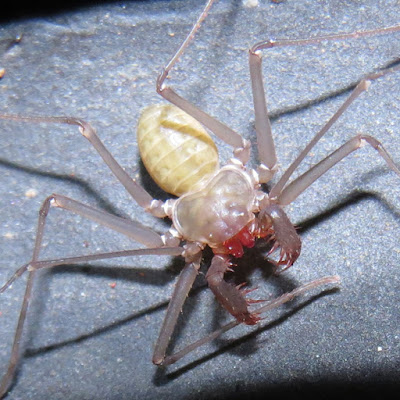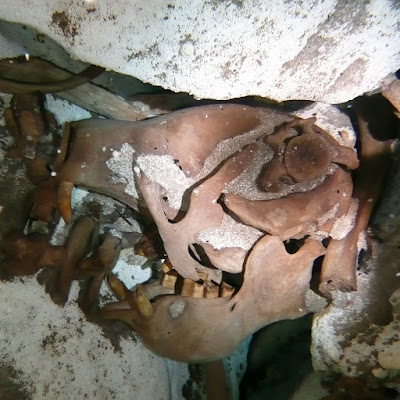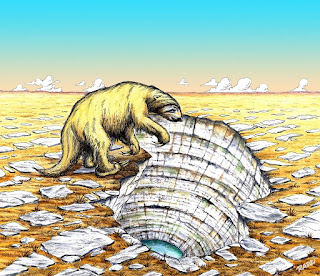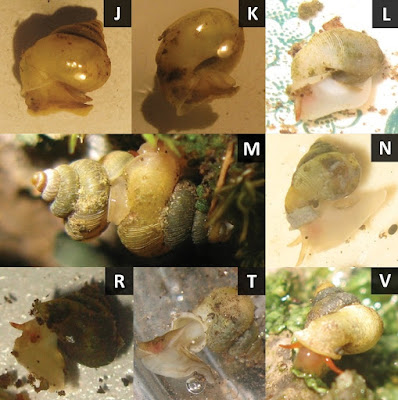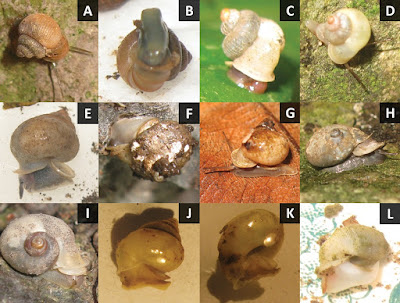[Most Recent Entries] [Calendar View]
Tuesday, August 29th, 2017
| Time | Event | ||||||
| 8:51a | [Arachnida • 2017] Charinus spelaeus & C. santanensis • Two New Species of Cave-dwelling Charinus Simon, 1892 (Amblypygi: Charinidae) from Brazil
Abstract Two new species of the genus Charinus are described from caves of Brazil: Charinus spelaeus sp. n., the fourth described species of the genus for the state of Minas Gerais, and Charinus santanensis sp. n., the sixth described species of the genus for the state of Bahia. Charinus spelaeus sp. n. has reduced median and lateral eyes, and is the sixth troglobitic Charinus described for Brazil. We present here an updated key and a distribution map for all the Brazilian species of Charinus. Keywords: Amblypygi, taxonomy, Neotropics, whip spider, troglobite, identification key Ana Caroline Oliveira Vasconcelos, and Rodrigo Lopes Ferreira. 2017. Two New Species of Cave-dwelling Charinus Simon, 1892 from Brazil (Arachnida: Amblypygi: Charinidae). Zootaxa. 4312(2); 277–292. DOI: 10.11646/zootaxa.4312.2.4 | ||||||
| 9:51a | [PaleoMammalogy • 2017] Xibalbaonyx oviceps • A New Megalonychid Ground Sloth (Folivora, Xenarthra) from the Late Pleistocene of the Yucatán Peninsula, Mexico, and Its Paleobiogeographic Significance
Abstract Here we describe a new genus and species of giant ground sloth, Xibalbaonyx oviceps (Megalonychidae, Xenarthra), from the drowned cave system of the northeastern Yucatán Peninsula. The specimen is Late Pleistocene in age and was discovered in the Zapote sinkhole (cenote) near Puerto Morelos in the Mexican state of Quintana Roo. Xibalbaonyx oviceps differs significantly from all hitherto known Megalonychidae including those from the Greater Antilles and South America. The new taxon suggests a local Caribbean radiation of ground sloths during the Late Pleistocene, which is consistent with the dispersal of the group along a Mexican corridor. Keywords: Ground sloths, Pleistocene, Yucatán Peninsula, Mexico Systematic palaeontology Superorder Xenarthra Cope, 1889 Order Pilosa Flower, 1883 Superfamily Megatherioidea Gray, 1821 Family Megalonychidae Gervais, 1855 Diagnosis of the family. Xibalbaonyx oviceps is identified as a member of Megalonychidae based on the following features: dorsal contour of skull evenly convex in lateral view. The glenoid fossa is mediolaterally widened, its posterior surface smooth and the fossa is well separated from the porus acusticus. The lateral plate of the entotympanic is thin with a medial expansion and weak participation in the floor of the tympanic cavity. The paroccipital process is well developed (Patterson et al. 1992; Gaudin 1995, 2004; McDonald et al. 2013b).
Xibalbaonyx oviceps gen. et sp. nov. Etymology. For the genus: Xibalbá = Maya for “underground” or “place of fear,” dedicated to the cave divers who dive into the “underworld,” the cenotes, and collect the fossils under risky conditions, but also in honor of the Yucatán Peninsula, which is also called the Maya region; “őνυξ” (onyx) = Greek for “claw” or “finger nail;” for the species: oviceps from ovum = Latin for “egg” and caput = “head,” “egghead,” referring to the regularly domed skull roof of the specimen. Stratigraphic and geographic distribution. The Cenote Zapote 16 Q 0486971 UTM 2305968, Ruta de los Cenotes Puerto Morelos Quintana Roo, Mexico. Late Pleistocene and/or Early Holocene (9.305 ± 35 14C bp, 10.647–10.305 cal bp). ..... Conclusions: The well-preserved skull and mandible of a ground sloth discovered in the Zapote cenote Cave near Puerto Morelos on the northeastern Yucatán Peninsula of Mexico is here described as a new genus and species of Megalonychidae. The individual, here named Xibalbaonyx oviceps, has a dental formula of 5/4 including a greatly enlarged caniniform tooth of triangular cross-section. This caniniform is separated by a long diastema from the molariform tooth rows in both the lower and upper jaw. The molariform teeth show oval, rounded rectangular to reniform (McDonald et al. 2013b) occlusal shapes with transverse crests. All teeth except for the upper caniniforms, show striations and apicobasal sulci that may be expressed as shallow grooves or deep sulci. The ascending process of the jugal is longer than the descending and middle process of the jugal. The pterygoids are inflated. The glenoid fossa is transversally widened. The skull is elongated and narrow, with a nasional impression on the nasals. The temporal lines are widely separated and do not form a sagittal crest. The skull is narrow and gracile compared that of other Megalonychidae of similar size, such as Megalonyx or Ahytherium. The Zapote ground sloth was a subadult individual, based on the degree of suture fusion in the skull, faint temporal lines and the condition of the occlusion faces of the molariforms. To present knowledge Xibalbaonyx appears to have been endemic on the Yucatán Peninsula, suggesting a local microevolution on this karst desert during the Late Pleistocene. Sarah R. Stinnesbeck, Eberhard Frey, Jerónimo Avíles Olguín, Wolfgang Stinnesbeck, Patrick Zell, Heinrich Mallison, Arturo González González, Eugenio Aceves Núñez, Adriana Velázquez Morlet, Alejandro Terrazas Mata, Martha Benavente Sanvicente, Fabio Hering and Carmen Rojas Sandoval. 2017. Xibalbaonyx oviceps, A New Megalonychid Ground Sloth (Folivora, Xenarthra) from the Late Pleistocene of the Yucatán Peninsula, Mexico, and Its Paleobiogeographic Significance. PalZ [Paläontologische Zeitschrift]. 91(2); 245–271. DOI: 10.1007/s12542-017-0349-5 Ancient species of giant sloth discovered in Mexico ctv.news/M8rqjqN Tízezer éve élt óriáslajhár maradványaira bukkantak Mexikóban http://www.origo.hu/tudomany/20170817-ar Kurzfassung: Die Unterwasserhöhlen auf der nordöstlichen Halbinsel Yukatan zeigen eine artenreiche Ansammlung von Großsäugern aus dem späten Pleistozän und frühen Holozän. Hier beschreiben wir die neue Gattung und Art eines Riesenfaultiers, Xibalbaonyx oviceps (Megalonychidae, Xenarthra), aus der Zapote Doline (Cenote) in der Nähe von Puerto Morelos im mexikanischen Bundesstaat Quintana Roo. Das Exemplar unterscheidet sich signifikant von allen bisher dokumentierten Megalonychidae einschließlich derjenigen von den Großen Antillen und aus Südamerika. Das neue Taxon deutet auf eine lokale karibische Radiation von Bodenfaultieren währen des Spätpleistozäns hin, die mit der Ausbreitung der Gruppe entlang des mexikanischen Korridors übereinstimmt. Schlüsselwörter: Bodenfaultiere Pleistozän Yukatan Halbinsel Mexiko | ||||||
| 11:41a | [Gastropoda • 2017] A Review of the Land Snail Genus Alycaeus (Gastropoda, Alycaeidae) in Peninsular Malaysia Abstract A total of 11 species and 1 subspecies of Alycaeus were recognised in Peninsular Malaysia prior to this study. However, these taxonomic descriptions of Alycaeus taxa were based on limited numbers of examined materials, where a whole spectrum of morphological variations were not accounted for and diagnoses were often provided without sufficient comparison between congeners from across the peninsula. We reviewed Peninsular Malaysian Alycaeus through the examination of 5137 specimens in 522 collection lots from all major museum collections and literature sources. Based on these examined materials, we utilised a more comprehensive revised set of 39 shell and operculum characters, as well as living animal colour to describe all Alycaeus species in this paper. We also noted their habitat and ecology, as well as updated the distribution of each species. Of the 12 previously described taxa, 10 are reconfirmed as present on Peninsular Malaysia (Alycaeus balingensis, Alycaeus carinata, Alycaeus conformis, Alycaeus gibbosulus, Alycaeus kapayanensis, Alycaeus kelantanensis, Alycaeus liratulus, Alycaeus perakensis perakensis, Alycaeus perakensis altispirus and Alycaeus thieroti) and 2 are confirmed as absent from the peninsula (Alycaeus jagori and Alycaeus pyramidalis). A new record of Alycaeus robeleni is reported for Peninsular Malaysia. One species, Chamalycaeus jousseaumei is confirmed as present on the peninsula and is reassigned to Alycaeus. The subspecies Alycaeus perakensis altispirus Möllendorff, 1902, is elevated to species. Examined Peninsular Malaysian materials that do not fit previously recognised species are described as new species. A total of 11 new species are proposed (Alycaeus selangoriensis sp. n., Alycaeus costacrassa sp. n., Alycaeus ikanensis sp. n., Alycaeus alticola sp. n., Alycaeus charasensis sp. n., Alycaeus kurauensis sp. n., Alycaeus regalis sp. n., Alycaeus virgogravida sp. n., Alycaeus senyumensis sp. n., Alycaeus expansus sp. n., Alycaeus clementsi sp. n.). Overall, 23 species of Alycaeus are now recognised in Peninsular Malaysia. Keywords: land snail, shell morphology, operculum, Alycaeinae, limestone karsts, Southeast Asia Junn Kitt Foon and Thor-Seng Liew. 2017. A Review of the Land Snail Genus Alycaeus (Gastropoda, Alycaeidae) in Peninsular Malaysia. ZooKeys. 692; 1-81. DOI: 10.3897/zookeys.692.14706 |
| << Previous Day |
2017/08/29 [Calendar] |
Next Day >> |
